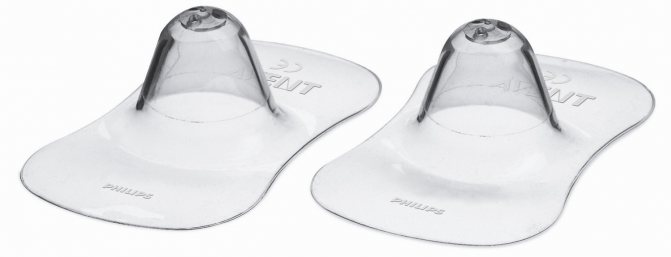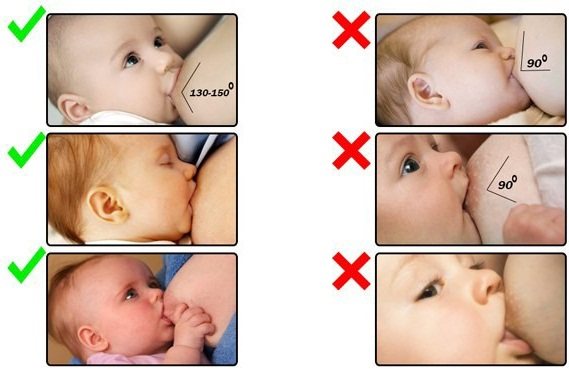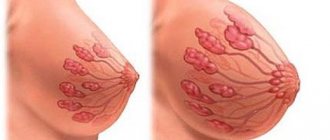Why do you need to put your baby to the breast correctly?
Proper attachment of your child is considered the foundation for the active development of the baby and his health. One of the most important moments in the first minutes of life is the attachment of the baby to the mother. Under the supervision of doctors, a mother feeds her baby for the first time. If a woman is familiar with how to properly breastfeed her child, she will tune in to this process much faster.
After several feedings of the baby, the mother will develop her own way of carrying out this action. The baby is just learning to eat properly, that is, to suck milk. The sucking skill improves over several months. In the first days it is very difficult for the baby, he begins to get used to the environment and this way of eating, so the mother fully controls this process and helps her child.
To ensure that the process does not present any discomfort and the mother does not feel pain, you should become familiar with feeding techniques and know how to properly apply a newborn to the breast for feeding.
Do not forget that feeding is very important for both the little man and the mother, it contributes to the following factors:
- activity of the baby, his health;
- proper nutrition for the baby;
- forming a bond between child and mother;
- preventing milk stagnation, which can cause mastitis;
- prevention of cracked nipples.
That is why every mother must know how to properly attach her baby for feeding and perform this action responsibly.
Baby's behavior during feeding
After birth, a little person is controlled by reflexes. It is thanks to them that the newborn already knows how to eat and makes attempts to find his mother’s breast. For example, close to her, the baby usually opens his mouth wide and begins to move his head slightly left and right. This is called search behavior.
Doctors insist that the child naturally knows how to apply himself correctly. It all depends rather on the adult, in whom this action is not determined by reflexes. Therefore, you will have to spend some time on training. Statistics say that only 30% of mothers put their babies to the breast correctly from the first day.
Application technique
Many young mothers have the idea of how to properly position their baby while feeding him. The technique of proper feeding will help you understand this issue. Feeding a crying baby is much more difficult than feeding a calm baby. Therefore, before the procedure, you should make sure that the little one is happy and has a clean diaper. Also, when feeding, it is necessary to create comfortable conditions for the baby, that is, choose the right position. Attaching the toddler to the chest should be asymmetrical. (Picture 1, Asymmetrical application)
Important! Remember that it is considered correct to put the baby to the breast, and not to give it to the baby!
First of all, the mother should choose a comfortable position for both the baby and herself. Since the feeding procedure is a fairly long process, an unsuccessfully chosen position can cause discomfort and pain. Most often, the little one turns its head towards the smell of milk. But it also happens that it’s time to feed, but the little one is not hungry. In such a situation, it is worth luring the child with a drop of milk on the nipple.
The mother should always hold the baby's head and also hold his shoulders. Thus, the baby's body is on the same line. The head is always turned towards the nipple. The baby almost always opens his mouth on his own when he is brought closer to the food item. A mother who knows how to properly attach a baby to the breast when feeding knows that her main task is to help the little person latch onto the breast. In addition, mommy holds the whole body from below.
If you did everything correctly, but you still feel discomfort, you should repeat the procedure for correct grip. It is worth repeating until all the signs of correct capture are realized.
Signs of proper attachment
How to properly breastfeed a newborn while lying down
If a mother is just figuring out how to properly attach her baby to the breast, she should know a number of signs that show whether everything is correct. This:
- The baby's cheeks are relaxed, rounded, the mouth is wide open;
- The lips are slightly turned outward (the degree of inversion varies: from imperceptible to strong);
- The baby's chin is pressed to the mother's chest;
- The nipple areola is completely (or almost completely) hidden in the baby’s mouth;
- Mom does not experience discomfort or pain;
- While the baby is eating, there are no extraneous sounds.
Signs of a successful breast latch
Every mother should know how to hold her baby while breastfeeding. The baby's body and head are located on the same line. The baby's face is turned towards mommy, the nose is located opposite the nipple. The mother holds the baby's entire body and presses him to herself.
A woman should remember to support her breasts while helping her baby. This should be done with the index finger from below the chest. But do not forget that your fingers should not be located close to the nipple.
To help the baby successfully capture the areola, you need to touch the baby's lips with the nipple. Then wait until the baby opens his mouth wide. Then gently move the child towards you, and point the lower lip lower than the nipple. The lips are pressed around the nipple, to the areola. It is necessary to pay attention that the baby’s lower sponge captures more of the nipple than the lower one. The baby should grab not just one nipple, but also a circle around it.
If the baby only sucks on the nipple, he will not be as full as he will not receive the required amount of milk. The toddler will be capricious, behave restlessly and may even stop sucking milk. Another consequence of improper breast latch may be the formation of cracks in the nipples, as well as their inflammation.
Also, the baby may have problems capturing the lower part of the areola in the first days due to the influx of a large volume of milk. In this case, it is better to express a little milk, and then help the baby to latch onto the breast correctly.

When the baby stops feeling hungry, he stops sucking and falls off the nipple. The newborn may fall asleep during the procedure and release the nipple. Do not wean your baby if the meal time has passed; give him the opportunity to decide for himself whether he will continue to eat or whether he is already full.
Note! Correct latching of the baby's breast indicates successful breastfeeding.
Experts highlight the main signs of proper grip:
- the newborn’s body should fit snugly to the mother’s body;
- the baby's lower lip seems slightly turned outward;
- The toddler captured the areola rather than sucking on one nipple;
- If the baby ate correctly, then at the end of feeding the mother will not experience pain or unpleasant feelings.
If mom is in pain
Pain is one of the signs of improper breastfeeding. It is important to note that this may also be the norm.
The fact is that the woman’s nipple area is very sensitive and delicate. Sucking milk from it is an active process that combines friction, stretching, and local increased pressure. All of this hurts. Therefore, during the first month, while lactation is just establishing, discomfort during feeding may haunt the mother. When the nipples get rough, it won't hurt. She must pay attention to the signs of the norm:
- There is pain only at the beginning, when applying it. After adaptation, feeding itself occurs without discomfort;
- The breast must be intact.
If the discomfort is constant, that is, both during latching and during feeding, then this is a sure sign that everything is going wrong. You should immediately stop and try to attach the baby correctly. Otherwise, the chest will be injured.
A crack or callus is a consequence of improper application. Moreover, the first one causes more discomfort than the second one - it causes acute pain and bleeds. In this case, it is better for the mother to use special pads that will protect the injured area from physical impact until complete healing, and learn to attach the baby to the breast correctly. If you cannot master the skill on your own, you should seek the help of a breastfeeding consultant. It can be found in a special organization - AKEV. They can also provide advice on breastfeeding issues.

An example of silicone breast pads from Avent
Incorrect chest grip
In the first days after the baby is born, mothers do not know how to properly put the baby to the breast for feeding. It is also problematic for mothers to choose a position for feeding. All people are individual and poses are varied. Some people will feel comfortable lying on their side, others will feel comfortable sitting leaning on a pillow, others can only feed their child while lying down. But the most famous pose is considered to be the “Cradle”. Mommy's hands are positioned like a cradle. The baby's head lies on the bend of the elbow on the side of the chest. Mom holds the baby's back and bottom. The baby should be in a stomach-to-belly position. (Picture 3, “Cradle” position)
It’s very easy to check your baby’s correct latch on the breast. After you hold the baby closer to you, you should look at where the baby’s gums are. They should cover not only the nipple, but also the areola. The milk ducts are located under the areola; by squeezing them, the required amount of milk flows in. If the little one grabs the breast incorrectly, this will lead to cracks, pain in the nipples and the baby will remain hungry.
If you notice that your child is not eating properly, you should stop feeding immediately. But it is very important to remove the nipple from the baby’s mouth only after the sucking has stopped, in order to prevent damage to the nipple. In order for the baby to stop sucking, you need to carefully insert your finger into the corner of the mouth. After which it is imperative to achieve the correct grip. If you don’t succeed, don’t panic, but try until you get it right.
Signs of violations
How to wean a baby to the breast
At first glance, it is difficult to determine whether everything is in order. Therefore, you need to know the signs that clearly indicate that something is going wrong:
- The baby does not grab the areola, presses with his gums, chews only the nipple;
- The mouth is not open wide, the lips are turned inward, and the cheeks are drawn in;
- Mom is in a lot of pain;
- Smacking and tapping can be heard.

Comparison of correct and incorrect applications
If there is something like that, you need to stop and breastfeed again, trying to do it correctly.
How to prepare for feeding
Learning to breastfeed can only be done through practice. The theory accumulated before childbirth helps a lot with this. In addition to mastering the provisions and rules themselves, you can resort to the following tips:
- Start using lanolin in the nipple area from 30-35 weeks of pregnancy, twice every day. It makes the skin denser, reducing the risk of cracks. Lanolin is recommended for use after childbirth between feedings. There is no need to wash it off like bepanthen (also often recommended for these purposes).
- Try to avoid bottles and pacifiers, at least until the skill of latching is fully mastered. This is because the child sucks the pacifier differently, it is easier for him to do this, which can cause problems.
Breastfeeding is a natural process. It is very important to learn it correctly. Then feeding will benefit the baby and pleasure for the mother.
About correct application
To breastfeed correctly , first of all, you need to hold the baby correctly . The position can be any, the main thing is that the baby is turned towards you with his whole body, his tummy is pressed tightly against your body, and his knees and nose are facing the same direction. The nipple should be at the level of the baby's upper lip and nose. Next, you need to form a fold from the breast (put your thumb on top, and the rest under the breast along the edges of the areola and squeeze), then tease the child a little (move the lips up and down). When your baby's mouth is wide open, insert your breast as deeply as possible while moving your baby's head with your other hand. It turns out to be counter traffic.
If there is a need to hold the breasts, there is no need to do it with “scissors” (hold between the index and middle fingers), since this is fraught with stagnation (fingers block the flow of milk). It is better to hold your chest in a “C” shape, that is, place your thumb on top and the other four fingers underneath your chest.
How to do it right
Mastering the breastfeeding technique is simple in theory. But it’s not easy to apply the acquired knowledge right away. But even in this case, mom absolutely must not despair and give up - a lot depends on her perseverance and positive attitude!
First of all, decide on the position. You can feed while lying down, sitting/half-sitting, standing (after an episiotomy, for example). When choosing a position, keep in mind that the baby can suckle at the breast for quite a long time, which means the mother should have the opportunity to relax and spend time in comfort.
In any position, the baby should be pressed tightly to the mother with his tummy and lightly reach for the nipple. The baby's mouth is wide open and deeply grips the areola, the nipple is directed towards the upper palate, the baby's lower jaw actively works when sucking, and the nose has access to air.
It is important to place a newborn for feeding while lying down in such a way that the mother lies flat (her head is not raised on a bent arm), and the baby’s mouth is at the same level as the nipple. Otherwise, it will pull on the chest, causing cracks and microtraumas. Lying on her side, the mother holds the baby by the butt and back, holding him close to her.
You shouldn’t fix the baby’s head, at most you can direct it towards the chest at the very beginning, and then the baby should be able to move it freely.
Many mothers worry that it will be difficult for the child to breathe because the nose rests on the chest. In fact, he feels completely comfortable in this position, receiving enough air through the edges of the spout. By pressing the breast from above with her fingers in order to help the baby breathe, the mother only makes it more difficult for him, because this impairs the flow of milk.
The remaining rules can be grouped as follows:
- correct application. Every child from the first seconds of life reflexively seeks the breast - this is an innate unconditioned reflex. To make the task easier for him, at first you can help a little - point the head towards the chest, move part of the areola along the lips. In response, the baby's mouth will open wide and he will be able to latch onto the breast correctly. At the same time, its lower lip will turn slightly outward and capture the lower edge of the areola. By the way, not all of it ends up in the child’s mouth - the lower part is larger than the upper. This type of grip is also known as an asymmetrical attachment - because the areola is not grabbed symmetrically.
- correct sucking. During the process, the mother can see part of the baby’s tongue covering the lower gum and sponge. It is the tongue and lower jaw that actively stimulate the milk ducts and “squeeze out” the milk. The cheeks move in rhythm with the sucking, the baby swallows deeply. The nose and chin are pressed tightly to the chest.
Mothers are often advised to feed their baby naked and undress to the waist themselves. Skin-to-skin contact ensures the development of the strongest bond between mother and baby.
Choosing a pose
The main criterion for the correct attachment of a baby to the breast is comfort for both mother and baby, so choosing a feeding position is a very important point. This is influenced by many factors: the mother’s well-being, the baby’s weight, sucking style and even the amount of milk. Depending on all these conditions, the following poses may be comfortable:
- "Cradle". Classic feeding position: the mother holds the baby in her arms, pressing his tummy to her stomach, while he grasps the nipple without turning his head.
- "Cross Cradle". The mother places the baby in her arm, holding the back of his head with her palm and supporting her chest with the other hand. This position ensures the most comfortable attachment for the baby.
- "From under the arm" or "from under the arm." The baby lies on a pillow, with his body behind his mother’s back. In this position, the baby receives milk from the upper and lower lobes of the breast, where lactostasis most often occurs.
- "Jack." The newborn lies on its side, the mother is located next to him, with his head in the opposite direction. The pose is convenient for stagnation of milk in the upper lobes.
- "On the chest." The mother reclines on her back and places the infant on top of her. This position is convenient when there is an excess of milk, when it flows in a strong stream, preventing the baby from sucking normally.
- "Overhang." The mother slightly turns the baby on his side and feeds, leaning on his elbow. The choice of this position for feeding is justified if it is necessary to facilitate the outflow of milk, but it requires little physical effort.
- "Standing." In some cases, the baby can be fed while standing, holding him in his arms in the “Cradle” position, which is especially convenient when rocking.
- "Sitting Child" When the baby can already sit, you can give him the breast without putting him down: as a rule, at this age, children are able to latch onto the nipple correctly without additional manipulation.
If during feeding both mother and baby feel relaxed, there is no discomfort or pain, and the breast is completely emptied, then the position has been chosen correctly. However, breastfeeding positions must be changed periodically: this will help avoid stagnation and develop good lactation.










